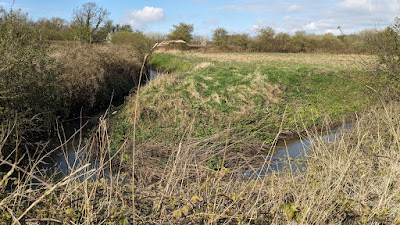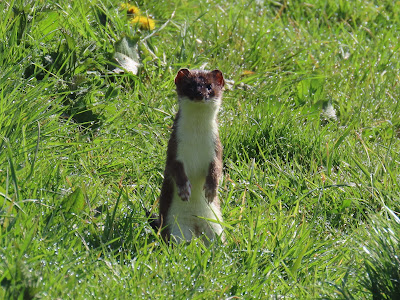A sunny, mild and still day, I get the 9:04 train to Hutton Cranswick. The station is facing east and in the sunshine, the flower beds give me a few bees for the day. The area around Driffield is very wet and there are few rights of way in the direction I want to go, so I opt for a detour via Skerne that might have well necessitated a boat in the last interglacial. I leave the station and head towards Cranswick village green. The name of the village comes from Cranes, which ties nicely with the Bustard theme from the last stage. Although Hutton Cranswick sits atop a chalk hill, the plains between it and the river Hull on the east are prone to flooding. The public right of way starts just by the post office, a lane bordered by flowering blackthorn. Chiffchaffs sing and Rooks squabble on their nests. I plod through a couple of very wet fields and have wet socks in no time. Rabbits scramble into the hedges.
At Hutton, just before I enter a community woodland by a chalk pit, I look east and the view is amazing. I wonder if you can see the sea in days with good visibility. A green lane by the church takes me to Howl Lane, and then the path cuts across a very wet paddock with horses. I consider walking by the fence, but they seem quite unfazed by my presence. I cross the railway line via a level crossing and then follow the railway line north until Northfield Beck, which leads to Skerne Beck and the river Hull. It is here that I have the best encounter of the day, a Stoat! I see it in the distance, going in and out of the grassy bank of the path in my direction, but it apparently hasn't noticed me. I take plenty of photos and stand quite still. When maybe five meters away, the Stoat stands up watching me with a puzzled look, and eventually disappears through the grass. I wonder if this is a typical hunting way, there are signs of rabbits in the area.
I walk along the single lane road, with regular traffic but good visibility until I get to Skerne Grange, where I turn left onto a public right of way that is a shortcut towards Driffield. I hear, and then spot a Curlew in the middle of a field. More Yellowhammers.
I take an alternative route via a public right of way by Skerne Hill farm to avoid the road. Meadow Pipits and a Lapwing in the middle of a fallow field. More Rabbits. I'm soon at the picturesque Bell Mills, by the River Hull (top shot). The river Hull has many sources, as numerous springs from the base of the chalk converge near its upper reaches. The western springs arising in the villages of Kirkburn (literally ‘Church Beck’, previously called Westburn), Eastburn, Southburn and Driffield Beck merge onto Driffield Trout Stream, before Bell Mills. I lean on the fence by the car park of the garden centre watching the river. This section of the river is a chalk stream, of beautiful clear water. There is a group of large Brown Trout, possibly from the trout farm upstream. I soon carry on towards the town centre to have some lunch and then take my train back home.
Today's stage has been the best mammal day of the trail so far, with Brown Hare, Rabbit, and Stoat seen, fresh Mole hills and Roe Deer tracks. Although I'm very happy with this, it would have been a very poor tally in the last interglacial.
Delta and SaltmarshThere was probably no cliff in this stretch of coast. The Driffield area would have been a bay, sheltered from northerly and westerly winds and therefore not subject to strong wave action. In addition, the area is crisscrossed by becks and springs, which now feed the river Hull, and it would have meant deposition of sediments, possibly forming a broad delta, with streams, dunes, saltmarsh and wetlands. It is likely to have been teeming with wildlife, and hence, a good place for predators to stalk prey.
The pride of the Wolds: Cave Lions
Cave Lions, Panthera spelaea, were widespread in Britain in the last ice age. Fossils have been found at many sites, including Kirkdale Cave in North Yorkshire - likely the most northern site, and also under Trafalgar Square. The Cave Lion is one of the best known extinct predators, with a plentiful fossil record. It is a different species to the modern Lion from which it diverged around half a million years ago. It was a larger, formidable predator, distributed from Britain and Iberia across Central Eurasia to Alaska and Yukon. Early humans in several areas of central Europe painted lions on cave walls and sculpted figurines in ivory, illustrating what the species would have looked like. Paintings at Chauvet Cave, displaying many individuals in naturalistic panoramas indicate that cave lions lived in prides, as the modern lion. The detailed paintings show that males lacked a mane. Isotope analysis of bones has been carried out, which provides information on their diet. We know that cave lion’s prey was diverse, from cave bears to reindeer, they made the best out of their locally available prey and opportunistically scavenged prey from hyena kills. They are likely to have hunted young elephants and hippos, deer and bison. Ancient DNA analysis has shown the relationship to modern lions and their genetic diversity. We even have mummies of Cave Lions, four Cave Lion cubs have been found in Siberia in recent years, where permafrost conditions meant they were extraordinarily well preserved.
A female Lion from Yorkshire Wildlife park. Cave Lion males lacked a mane, they are also likely to have a thick winter coat.
Unfortunately not. Cave Lions became extinct during the last ice age, about 14,000 years ago, earlier in the UK. You can see their closest living relatives, modern Lions, in many zoos, including Yorkshire Wildlife Park.
More information
de Manuel, M. et al. The evolutionary history of extinct and living lions. Proc. Natl. Acad. Sci. U. S. A. 117, 10927–10934 (2020).
Barnett, R. The Missing Lynx: The Past and Future of Britain’s Lost Mammals. (Bloomsbury Publishing, 2019).
Barnet, R. Fossil lions of Europe.
Stanton, D. W. G. et al. Early Pleistocene origin and extensive intra-species diversity of the extinct cave lion. Sci. Rep. 10, 12621 (2020).
Stuart, A. J. & Lister, A. M. Extinction chronology of the cave lion Panthera spelaea. Quat. Sci. Rev. 30, 2329–2340 (2011).


























No comments:
Post a Comment